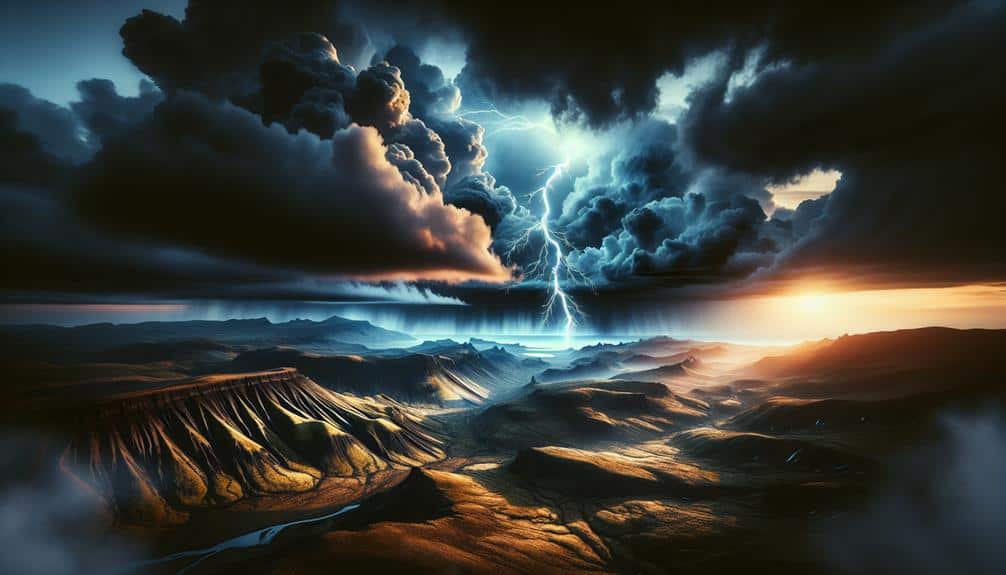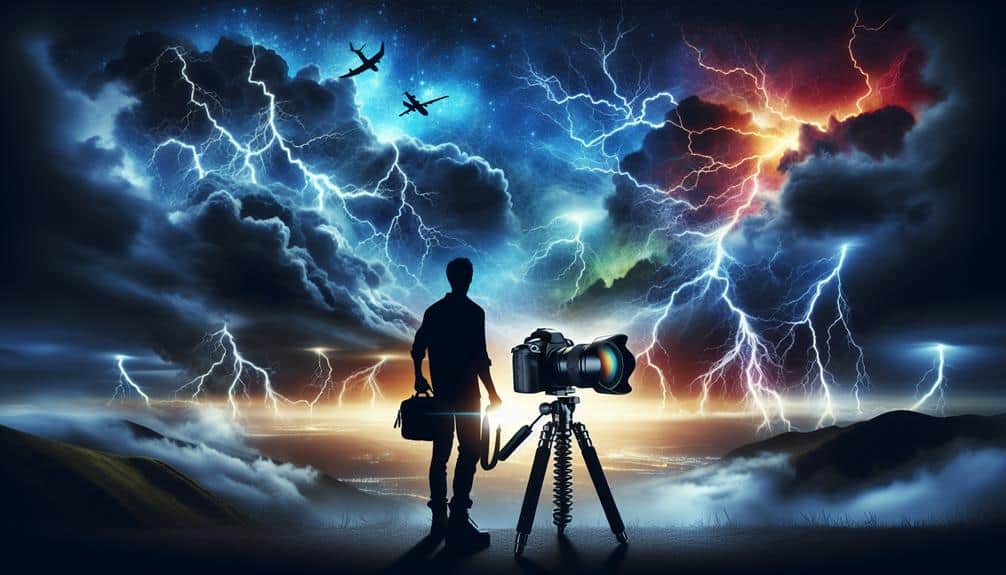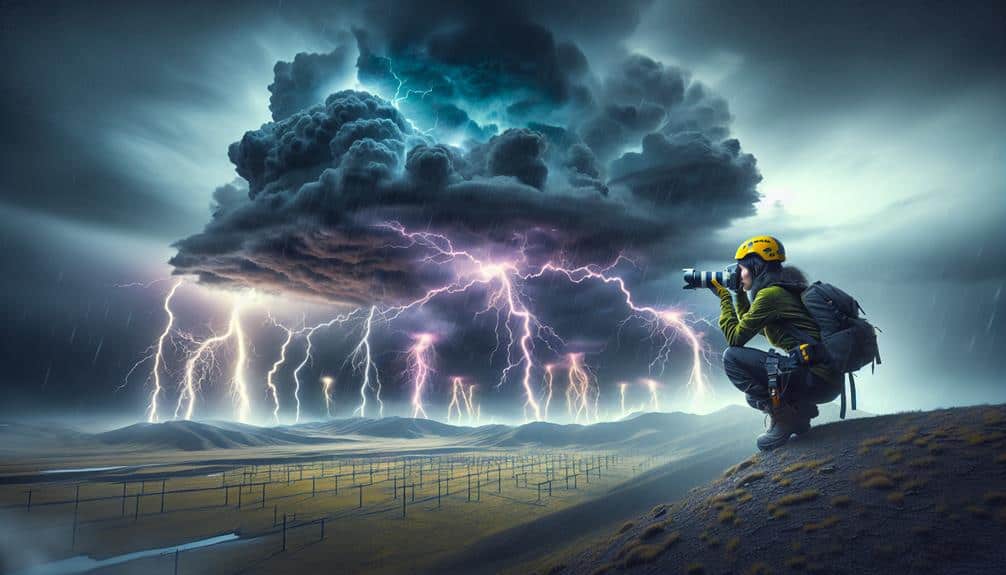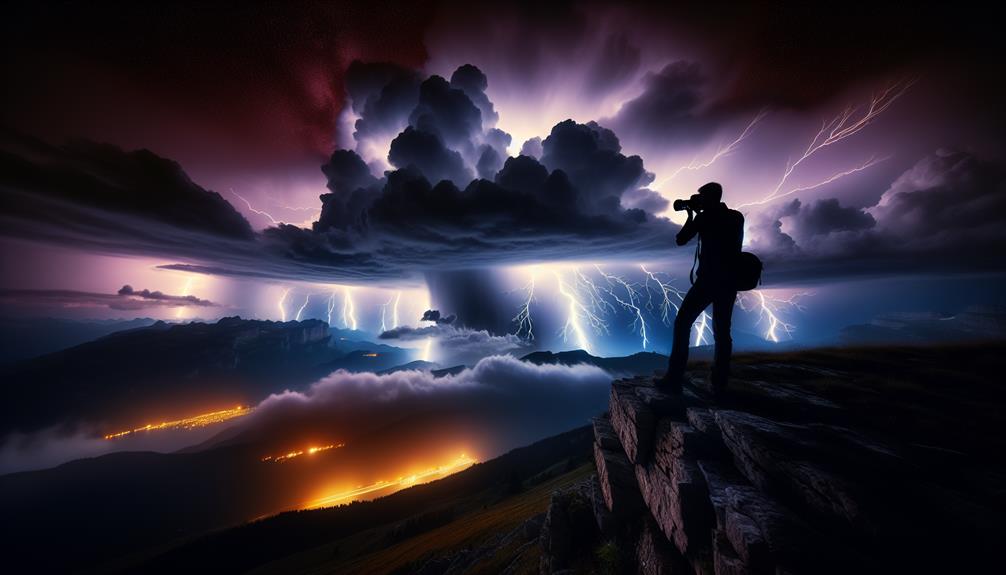Chasing lightning strikes in remote areas requires us to carry essential gear like first aid kits, portable water filters, and GPS devices with topographic maps. We must conduct thorough risk assessments, identify shelters, and establish clear evacuation plans. The best locations include Venezuela's Catatumbo River and the Great Plains in the U.S., with ideal weather conditions featuring high humidity and atmospheric instability. For photography, using a sturdy tripod, long exposures, and post-processing techniques enhances our captures. By understanding these essentials, we can maximize both our safety and success in storm chasing. There's much more to master for a rewarding experience.
Key Points
- Conduct thorough risk assessments and establish clear evacuation plans before setting out for storm chasing in remote areas.
- Pack essential gear, including a complete first aid kit, portable water filter, and reliable navigation tools.
- Target regions with high humidity, atmospheric instability, and convective activity for optimal lightning conditions.
- Utilize a sturdy tripod, remote shutter release, and manual camera settings to capture dramatic lightning photographs.
Essential Gear Checklist
What gear should we prioritize to guarantee safety and efficiency while chasing lightning strikes in remote areas?
First, let's focus on emergency supplies and navigation tools, which are vital for our adventures.
For emergency supplies, we should pack a complete first aid kit tailored for remote locations. This must include bandages, antiseptic wipes, pain relief medication, and a CPR mask. Additionally, a portable water filter and emergency food rations ensure we stay hydrated and nourished. A reliable multi-tool and fire-starting kit are essential for unplanned survival situations.
Navigation tools are equally important. A GPS device with topographic maps is essential for precise navigation, especially in areas with limited cellular coverage. We should also carry a traditional compass and waterproof maps as backups. Using a weather radio to stay updated on storm movements provides an edge in predicting lightning activity and staying safe.
Safety Precautions
While our gear guarantees we're well-prepared, understanding and adhering to safety precautions is essential to mitigate risks during our lightning chasing expeditions. First, we must conduct a thorough risk assessment before setting out. This involves analyzing weather forecasts, terrain data, and potential hazards. By evaluating these factors, we can tailor our emergency procedures to specific scenarios, enhancing our safety.
Identifying lightning shelters is crucial. Natural formations like caves or low-lying areas can offer temporary refuge. However, we should always scout for man-made structures such as vehicles or buildings, which provide superior protection. Knowing the locations of these shelters ahead of time allows for swift action during sudden weather changes.
Evacuation plans are another important aspect. We must establish clear routes and protocols for quickly leaving an area if conditions deteriorate. Regular drills and rehearsals guarantee everyone knows their role and actions during an emergency.
Data from the National Weather Service indicates that lightning-related fatalities often occur due to delayed reaction times. By integrating prompt risk assessment and well-practiced emergency procedures, we minimize our exposure to danger.
Best Remote Locations
Several remote locations across the globe offer ideal conditions for lightning chasing, combining high storm activity with accessible vantage points. One of the top spots is the Catatumbo River in Venezuela. Known for producing nearly 260 storm nights per year, this secluded destination is a lightning enthusiast's dream. We can strategically plan our adventure around the peak lightning months from April to November.
Another prime location is the Great Plains in the United States, particularly in Oklahoma and Kansas. These areas are famous for their frequent thunderstorms and expansive plains, providing unobstructed views. With proper adventure planning, we can navigate the less-traveled roads and find off-grid exploration opportunities that bring us closer to the action without compromising safety.
For those seeking an international experience, the Lake Maracaibo region also stands out. This area sees lightning storms almost 300 nights a year. Remote yet accessible, it offers unparalleled lightning activity.
Similarly, Northern Australia's Top End region, especially during the monsoon season, provides dramatic electrical storms with minimal light pollution.
Ideal Weather Conditions
To effectively pursue lightning, we need to target regions with high humidity, atmospheric instability, and frequent convective activity. These conditions are key for storm chasing and capturing stunning lightning photography. High humidity provides the moisture necessary for cloud formation, while atmospheric instability, often indicated by a high Convective Available Potential Energy (CAPE) value, leads to the turbulent air movements essential for thunderstorms.
Convective activity is another vital factor. It's driven by temperature differences in the atmosphere, causing warm air to rise and cool air to sink, generating the electrical charges that produce lightning. Areas such as the Great Plains in the U.S. or the monsoon regions in India are exemplary due to their consistent convective storms.
We should also monitor weather models and real-time data from sources like the Storm Prediction Center (SPC) or local meteorological services. These tools provide essential information about potential lightning activity and storm paths, helping us plan our storm chasing expeditions safely and effectively.
Photography Techniques

Mastering lightning photography requires a blend of technical prowess and situational awareness to capture the fleeting brilliance of a lightning strike.
First, let's talk camera settings. We'll need a sturdy tripod to keep the camera still, and a remote shutter release to avoid camera shake. Set the camera to manual mode, with a low ISO (100-200) to minimize noise, and an aperture between f/8 and f/16 for excellent depth of field. Shutter speed is key; long exposures ranging from 5 to 30 seconds are ideal for capturing multiple lightning bolts in one frame.
Now, on to composition tips. Framing the shot with an interesting foreground, such as a lone tree or a mountain range, can add depth and context. Keep an eye on the horizon; a level horizon line keeps the image grounded.
Post-processing is where the magic happens. Using editing software like Adobe Lightroom or Photoshop, we can enhance the contrast and clarity of the lightning bolts. Adjusting the white balance can also help bring out the natural colors in the sky. Employing advanced post-processing techniques, such as layer masking and selective sharpening, can further refine the image, making it truly spectacular.
Frequently Asked Questions
What Are the Legal Considerations for Storm Chasing in Protected Areas?
We must consider permit requirements and the impact on protected species. Acquiring the right permits guarantees we're legally compliant, while being mindful of protected species helps us avoid disrupting their habitats during our storm-chasing adventures.
How Can I Track Lightning Strikes in Real-Time?
To track lightning strikes in real-time, we use apps like Blitzortung and LightningMaps. For lightning safety, precautions include monitoring weather updates and having an emergency plan. For lightning photography, techniques involve using long exposures and a sturdy tripod.
What Apps or Websites Are Best for Weather Forecasting?
Did you know lightning strikes Earth about 100 times per second? For effective storm tracking, we recommend using weather radar apps like RadarScope. For thorough weather app comparison, websites like Weather Underground offer real-time lightning alerts.
How Do I Maintain My Vehicle for Off-Road Storm Chasing?
For off-road vehicle maintenance and remote storm chasing, we regularly check tire treads, suspension, and fluid levels. We also guarantee our vehicle's electrical systems are robust, as reliable performance is essential in unpredictable, harsh environments.
What Are the Best Strategies for Networking With Other Storm Chasers?
We should prioritize safety protocols and effective communication methods. Using real-time data-sharing apps and social media platforms, we can coordinate our locations, share weather updates, and guarantee everyone's safety while maximizing our storm chasing experiences.


